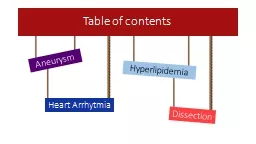

Dissection Heart A rrhytmia Hyperlipidemia Aneurysm Nicolas Alvarez Aneurysm a bloodfilled bulge of a blood vessel it usually affects arteries of the brain or the abdominal aorta very dangerous possibility of internal ID: 778946
Download The PPT/PDF document "Table of contents Aneurysm" is the property of its rightful owner. Permission is granted to download and print the materials on this web site for personal, non-commercial use only, and to display it on your personal computer provided you do not modify the materials and that you retain all copyright notices contained in the materials. By downloading content from our website, you accept the terms of this agreement.
Slide1
Table of
contents
Aneurysm
Dissection
Heart
A
rrhytmia
Hyperlipidemia
Slide2Slide3Aneurysm
Nicolas
Alvarez
Slide4Slide5Aneurysma blood-filled bulge of a blood vesselit usually affects arteries of the brain or the abdominal aorta
very dangerous – possibility of internal bleeding
Slide6Slide7Aneurysm
Rupture
of
the
aorta with aneurysm
Slide8Slide9Aneurysmcauses of aneurysm: hypertension
, inflammation of the vessel wall, atherosclerosissymptoms:
sharp and severe paindiagnostics: ultrasound or CTtreatment: surgery
is needed; blood pressure and cholesterol reduction (supportive treatment
)
Slide10Slide11Dissection
Zuzana
Kaščáková
Slide12Slide13Dissectionthe rupture of the inner wall of a vesselit usually affects the aorta in the chest
it may cause a heart-attack, a stroke, paralysis of some parts of the body
Slide14Slide15DissectionComparation
– normal aorta and dissected aorta
Dissection
Slide16Slide17Dissectioncauses: hypertension, atherosclerosis, thinning blood vesselssymptoms:
sudden paindiagnostics: ECGtreatment: abdominal aorta – surgery is not always needed, any other dissection requieres surgery
Slide18Slide19Heart
arrhythmia
Marek Timoracký
Slide20''An irregular heartbeat is an arrhythmia.
''
Slide21What causes an arrhythmia?
Coronary artery diseaseElectrolyte imbalances in your blood (such as sodium or potassium)Changes in your heart muscleInjury from a heart attackHealing process after heart surgeryIrregular heart rhythms can also occur in "normal, healthy" hearts
Slide22Slide23Types of arrhythmiasPremature
atrial contractionsPremature ventricular contractionsAtrial
fibrillationAtrial flutterParoxysmal supraventricular tachycardia
Accessory pathway tachycardiasAV nodal reentrant
tachycardiaVentricular tachycardia
Ventricular
fibrillation
Long
QT
syndrome
BradyarrhythmiasSinus node dysfunctionHeart block
Slide24Slide25Premature ventricular contractions
What
Causes
PVC?
Heart
attackHigh
blood pressureCardiomyopathyDisease
of heart valves HypokalemiaHypomagnesemia
Hypoxia
Medications
Excessive
intake
of
alcohol
Excess
caffeine
intake
Stimulant
drug
use
Myocarditis
Cardiac
contusion
Slide26Slide27Atrial fibrillation
What Causes Atrial
Fibrillation?Poorly controlled high blood pressure
(hypertension)Heart valve problemsCoronary artery
diseaseAlcohol abuseObesitySleep apnea
(pauses in breathing)Thyroid disorders
Slide28Slide29Paroxysmal supraventricular tachycardia
What Causes PST?Excessive intake of alcohol
Excess caffeine intakeElectrolytes abnormalitiesAbnormal
thyroid levelsMedications
Slide30Slide31Diagnostics
Electrocardiogram (EKG)Holter monitorEchocardiographyExercise
cardiac stress testBlood tests
Slide32Slide33Treatment
Antiarrhythmia medicationsImplantation of a pacemaker
Surgery
Slide34Slide35Lenka Polláková
Hyperlipidemia
Slide36Slide37abnormally elevated levels of any lipids in the blood
vs.
always your decision?What
is hyperlipidemia
Slide38Slide39primarygenetic causes
check your family history
minimize your risk through diet and exercise
secondary acquiredunhealthy lifestyle
underlying causes – drugs (diuretics, estrogens, beta blockers
), diabetesClassification
Slide40Slide41fatty substances travel in the blood attached to proteins – lipoprotein
How
it
works
LDL (low density lipoprotein
) ,,bad cholesterol“
its excess - blockage of arteries – heart attack
HDL (high density lipoprotein) „good cholesterol“lower level – coronary heart disease
Slide42Slide43no symptomsBUT !
elevated chance of heart diseases
How
it
looks
Slide44Slide45- eat healthy -
- read food labels -- limit red
meat, eggs, fried food -- increase
the amount of fiber --
lose extra weight -- exercise regularly -
Ups
, I
have
it
Slide46Slide47-
live
healthier -Thank
you for your attention